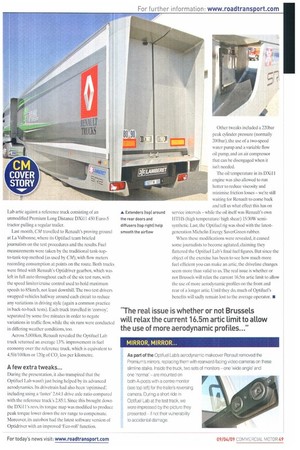In the Long run...
Page 48

Page 49

If you've noticed an error in this article please click here to report it so we can fix it.
On the face of It
,a13% 13% improvement in fuel consumption over a conventional artic would seem to be a good deal. But, like so many other things in life, it comes with strings attached. And those strings need to be cut by the bureaucrats in Brussels.
Put simply, they need to allow longer artics if European truck operators are to gain any benefit from vehicles such as the Renault Optifuel lab. Unveiled, ironically enough, in Brussels late last year, the aerodynamic concept artic has been developed with the primary goal of cutting fuel consumption and emissions.
To achieve the former (and deliver the latter), Renault's engineers have taken a standard 450hp Premium Route DXill 4x2 tractor and added a 30cm extended aero-nose that incorporates a special wraparound bumper on the front. The tractor's roof has also been re-profiled and raised to 4.16m, so that it acts as an integral deflector.
Behind the tractor sits an extra-slippery Lamberet triaxle box trailer with a collar at the back with vanes that extend rearwards by 70cm and fold back out of the way when the rear doors are opened. Full-length side valances not only encapsulate the axles, but also feature unusual 'diffusers' (borrowed, says Renault, from Formula 1) built into the rear corner sections to smooth out the airflow as it leaves the back of the trailer — this further reduces drag.
The area around the landing legs has also been fared in, and the trailer roof is slightly bowed to help simulate the ideal aerodynamic shape of a water droplet —although with a 4.0m Continental height limit, it's far less than on a Don-Bur 'Teardrop' trailer.
Close attention has been paid to the tractor/trailer coupling gap, with collars extending from the back of the cab and deep side valances between the tractor's axles ensuring an extremely 'snug' lit — rubber 'extenders' close
the gap even further to around 300mm at the top of the trailer to 152mm at the bottom — the rubber extensions also ensure that any contact during articulation doesn't result in damage. The result is an all-but-seamless airflow from the front of the truck to the back, with Renault's engineers citing a 25% improvement in the Optifuel lab's drag co-efficient (or Cx) compared to a normal arties.
Putting it to the test
After extensive computer-based studies to predict the performance of Optifuel. Renault recently conducted a series of 'real-life' road trials around a 400km course used by French transport magazines. Renault pitted its Optifuel Lab artic against a reference truck consisting of an unmodified Premium Long Distance DXili 450 Euro-5 tractor pulling a regular trailer.
Last month, CM travelled to Renault's proving ground at La Valbonne, where its Optifuel team briefed journalists on the test procedures and the results. Fuel measurements were taken by the traditional tank-topto-tank-top method (as used by C111), with flow meters recording consumption at points on the route. Both trucks were fitted with Renault's Optidriver gearbox, which was left in full auto throughout each of the six test runs, with the speed limiter/cruise control used to hold maximum speeds to 85krn/h, not least downhill. The two test drivers swapped vehicles halfway around each circuit to reduce any variations in driving style (again a common practice in back-to-back tests). Each truck travelled in 'convoy: separated by some five minutes in order to negate variations in traffic flow, while the six runs were conducted in differing weather conditions, too.
Across 5,000km, Renault revealed the Optifuel Lab truck returned an average 13% improvement in fuel economy over the reference truck, which is equivalent to 4.5lit/100km or 120g of CO2 less per kilometre.
A few extra tweaks...
During the presentation, it also transpired that the Optifuel Lib wasn't just being helped by its advanced aerodynamics. Its drivetrain had also been 'optimised: including using a 'faster' 2.64:1 drive axle ratio compared with the reference truck's 2.85:1. Since this brought down the DXill's revs, its torque map was modified to produce peak torque lower down the rev range to compensate. Moreover, its autobox had the latest software version of Optidriver with an improved 'Eco-roll' function.
















































































































































